
Holy Trinity Church is in Church Road, Wavertree, Liverpool, Merseyside, England. It is an active Anglican parish church in the diocese of Liverpool, the archdeaconry of Liverpool, and the deanery of Toxteth and Wavertree. The church is recorded in the National Heritage List for England as a designated Grade II* listed building. It was described by John Betjeman as "Liverpool's best Georgian church".
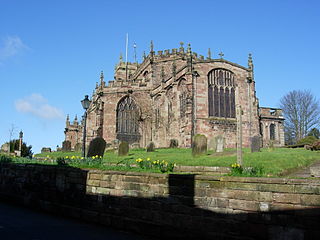
St Oswald's Church stands on the highest point in the market town of Malpas, Cheshire, England, on or near the site of a Norman motte and bailey castle. The church is recorded in the National Heritage List for England as a designated Grade I listed building and is recognised as being one of the best examples in Cheshire of a late 15th to early 16th-century church. It is an active Anglican parish church in the diocese of Chester, the archdeaconry of Chester and the deanery of Malpas. Its benefice is combined with those of St John, Threapwood, and Holy Trinity, Bickerton. Alec Clifton-Taylor includes it in his list of 'best' English parish churches.
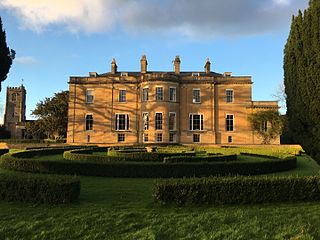
Dinder House, is a Somerset estate with a small country house Grade II Regency listed building in the village of Dinder, in the civil parish of St Cuthbert Out in Somerset. Dinder House was formerly a manor house dating back to the 12th century, but the existing building was constructed between 1799 and 1801 by the Rev William Somerville on the original site. The estate remained as the seat of the Somerville family until the late twentieth century.

Dulwich Park is a 30.85-hectare (76.2-acre) public park in Dulwich in the London Borough of Southwark, south London, England. The park was created by the Metropolitan Board of Works from former farmland and meadows. While the initial design was by Charles Barry (junior), it was later refined by Lt Col JJ Sexby. It was opened in 1890 by Lord Rosebery. From 2004 to 2006, the park was restored to its original Victorian layout, following a grant from the Heritage Lottery Fund. The park is listed Grade II on the Register of Historic Parks and Gardens.
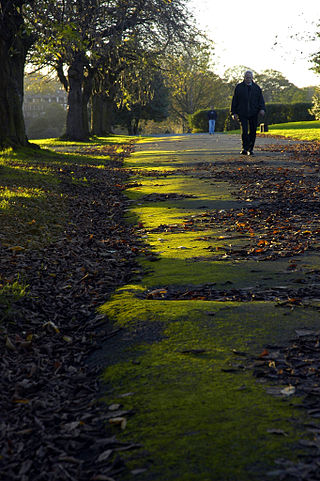
Armley Park is a large public park located next to Stanningley Road in Armley, on the outskirts of Leeds, in West Yorkshire, Northern England.

Dodington Park is a country house and estate in Dodington, South Gloucestershire, England. The house was built by James Wyatt for Christopher Bethell Codrington. The family had made their fortune from sugar plantations in the Caribbean and were significant owners of slaves. It remained in the Codrington family until 1980; it is now owned by the British businessman James Dyson.

St Bartholomew's Church is in the village of Great Barrow in the civil parish of Barrow, Cheshire, England. It is recorded in the National Heritage List for England as a designated Grade II* listed building. It is an active Anglican parish church in the diocese of Chester, the archdeaconry of Chester and the deanery of Chester.

St Helen's Church is in the village of Tarporley, Cheshire, England. It is an active Anglican parish church in the diocese of Chester, the archdeaconry of Chester and the deanery of Malpas. Its benefice is united with those of St John and Holy Cross, Cotebrook, St Thomas, Eaton, and St Paul, Utkinton. The church is recorded in the National Heritage List for England as a designated Grade II* listed building.

St Mary's Church is a redundant Anglican church in the small village of Thornton-le-Moors, Cheshire, England. The church is recorded in the National Heritage List for England as a designated Grade I listed building, and it is in the care of the Churches Conservation Trust.

The National Submariners' War Memorial is a war memorial on the Victoria Embankment in London, England, between Waterloo Bridge and Blackfriars Bridge. The memorial is also referred to as the National Submarine War Memorial, the National Submarine Memorial, the Submarine War Memorial and the Submariner Memorial. It commemorates the Royal Navy submariners who died in the First and Second World Wars. The Royal Navy Submarine Service had 57 operational vessels at the start of the First World War in 1914, but expanded to 137 vessels by the time the war ended in 1918, with another 78 under construction. During the war, 54 of its submarines were sunk, and over 1,300 Royal Navy submariners were killed. The memorial is a Grade II* listed building, and it is the focal point of a special memorial walk and laying of wreaths held each year by submariners on the Sunday preceding Remembrance Sunday.
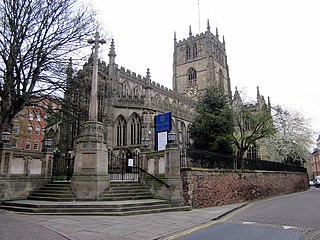
The County War Memorial, Nottingham is a Grade II listed structure in Nottingham in Nottinghamshire, England.

Southport War Memorial is in London Square, Lord Street, Southport, Merseyside, England. It consists of an obelisk flanked by two colonnades in the form of Greek temples. Outside the colonnades are memorial gardens, each containing a Pool of Remembrance and fountains. The memorial was designed by the local architects Grayson and Barnish, and the carving was executed by Herbert Tyson Smith. It was unveiled in 1923 by the Earl of Derby. Following the Second World War and subsequent conflicts further inscriptions and names have been added. The memorial is recorded in the National Heritage List for England as a designated Grade II* listed building.

St Nicholas Church is an active Anglican parish church in the diocese of Chester on Newport Avenue, in Wallasey, in Wirral, England. It was designed by J. F. Doyle and built in 1910–11. The church is located near Wallasey Golf Club and is known as the Harrison Memorial Church or the Golfers' Church. It is recorded in the National Heritage List for England as a designated Grade II listed building.

Helsby War Memorial was built to commemorate the servicemen of Helsby lost in active service in the First World War. It was unveiled in 1920, and the names of those lost in the Second World War were added later. The memorial stands in the churchyard of St Paul's Church in Helsby, Cheshire, England, and consists of a Celtic cross in sandstone on a pedestal and steps. On the shaft of the cross is an inscription and on the pedestal are the names of those lost in the conflicts. The war memorial is recorded in the National Heritage List for England as a designated Grade II listed building.
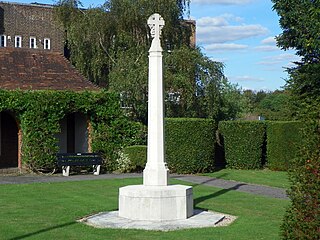
The Hatfield War Memorial is a war memorial beside the Great North Road in Hatfield, Hertfordshire. It was one of 24 war memorials in England designed by Sir Herbert Baker, that were designated as a national collection by Historic England in 2017. The memorial is located near the gates of Hatfield House, and close to Hatfield railway station. It was unveiled in 1921, to commemorate 139 men from Hatfield killed on service during the First World War. A brick pavilion records the names of the dead, with further names added after the Second World War.

The Barnet Boys School Boer War Memorial is located opposite Christ Church on the St Albans Road in Chipping Barnet, London. It marks the deaths of the eight former pupils of Barnet Boys School who died in the Second Boer War of 1899 to 1902 and was unveiled by Field Marshal Lord Grenfell in July 1903. It has been grade II listed on the National Heritage List for England since June 2017. The heritage listing describes the monument as "simple yet dignified".

The Royal Artillery Boer War Memorial is located on the south side of The Mall in Central London, close to the junction with Horse Guards Road at the northeast corner of St James's Park. Unveiled in 1910, it marks the deaths of the 1,083 soldiers of the Royal Artillery who died in the Second Boer War from 1899 to 1902 It has been a listed building since 1970.

The Winchester College War Cloister is a war memorial at Winchester College, in Hampshire, designed by the architect Sir Herbert Baker. The roofed quadrangle is said by Historic England to be the largest known private war memorial in Europe. It became a Grade II listed building in 1950, and was upgraded to Grade I in 2017, as one of 24 war memorials in England designed by Baker that were designated by Historic England as a national collection.

The Dulwich College War Memorial is located at the eastern front of Dulwich College on College Road in Dulwich in the London Borough of Southwark. It commemorates the alumni of the college who died in both the First and Second World Wars. The memorial was designed by W. H. Atkin-Berry, an alumnus of the college. It was unveiled on 17 June 1921, the Dulwich College Founder's Day, by Major General Sir Webb Gillman, and dedicated by the Dean of Durham, James Welldon. Gillman was an alumnus of the college, and Welldon had served as Master of Dulwich College from 1883 to 1885. It has been Grade II listed on the National Heritage List for England since May 2010. The heritage listing places the memorial within a "visual and contextual relationship" with the Grade II* listed Main College building.

Tiverton Cemetery is the burial ground for the town of Tiverton in Devon. The cemetery covers eight acres and is owned and maintained by Mid Devon Council.




















